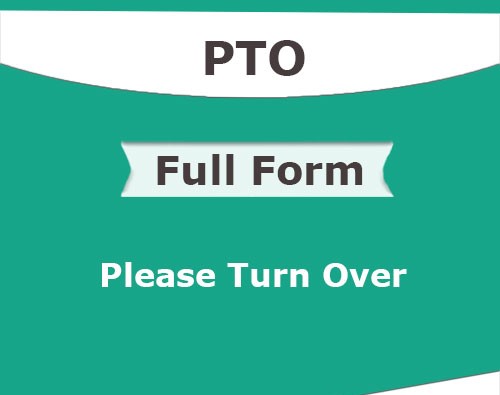PTO stands for Please Turn Over. It is usually written at the bottom of a page to request the reader to turn the page. It is used to show that additional information is given on the other side or next page. For example; you are writing a paper on science. On one page after writing the description you want to draw a diagram but you are left with only five lines below the description where you can?t draw the complete diagram.

Understanding the Phrase
- The phrase “The early bird catches the worm” is a proverb that conveys the idea that being proactive and taking action early can lead to success or an advantage. In essence, it emphasizes the importance of being prompt and diligent in pursuing one’s goals or responsibilities.
- This saying suggests that those who start their day or tasks early have a better chance of achieving their objectives compared to those who procrastinate or delay action. It implies that early risers or individuals who take initiative are more likely to seize opportunities, accomplish tasks efficiently, and stay ahead of the competition.
- Metaphorically, the “worm” represents opportunities, rewards, or success. By being proactive and not procrastinating, one can “catch” these opportunities or achieve their goals.
- While this proverb highlights the benefits of timeliness and proactive behaviour, it’s important to note that success also depends on various other factors like planning, preparation, and persistence. Nonetheless, it serves as a reminder that taking action promptly can lead to favourable outcomes in many aspects of life.
Incorporating "PTO" in Writing
“Incorporating the phrase ‘Please Turn Over’ in your writing can enhance the flow and organization of your document. When strategically placed, it serves as a helpful cue to your readers, guiding them to continue reading on the next page or revealing additional content that complements the current page. This simple instruction can be particularly useful in presentations, reports, or manuals, ensuring that your audience doesn’t miss important information. Whether you’re presenting a sequence of steps, revealing a surprise element, or providing additional context, ‘Please Turn Over’ acts as an invitation to delve deeper into your content. Just remember to use it judiciously, keeping your readers’ experience in mind, and ensuring that it enhances the overall comprehension and engagement with your document.”
Turning Pages and Digital Equivalents
Turning pages is a traditional action associated with physical books, magazines, or printed materials. It involves physically flipping a page from one side to another to continue reading or accessing new content. This tactile experience has been a fundamental part of reading for centuries.
In the digital age, the concept of turning pages has evolved into its digital equivalent. E-books and e-readers have replaced physical books for many readers. With a swipe or a tap on a screen, readers can virtually “turn” pages and navigate through the content. This digital transition has made reading more convenient, portable, and accessible, as entire libraries can be stored on a single device.
The Future of "Please Turn Over"
The future of “Please Turn Over” in the context of traditional printed materials is undoubtedly undergoing a significant shift. With the increasing prevalence of digital media and the decline in printed publications, the phrase’s relevance in physical documents is diminishing. As more readers opt for e-books, digital magazines, and online articles, the act of physically turning a page is becoming less common.
However, “Please Turn Over” still holds a place in certain printed materials, particularly in instructional manuals, workbooks, and some educational resources. In these contexts, it serves as a helpful guide to ensure readers don’t miss crucial information.
Conclusion
In conclusion, the phrase “Please Turn Over” (PTO) has been a longstanding and valuable cue in printed materials, guiding readers to access additional content on the next page. While its relevance in traditional printed documents is waning due to the digital transformation of media, it still serves a purpose in specific contexts such as instructional manuals and educational materials.
FAQ's About PTO
PTO is used to guide readers and ensure they don’t miss important information or content that continues on the next page.
PTO’s relevance has decreased in the digital age, as physical page-turning is less common with the transition to digital media.
In digital documents, alternatives to PTO include clickable links, buttons, or prompts that encourage users to navigate to the next section or access supplementary content.
PTO is typically used in printed materials where it’s essential to maintain the sequential flow of information.
Related posts:
- AMC Full Form: Benefits, Components, Needs, Advantage
- ORS Full Form: Dehydration, Myths, Flavors, Varieties & Facts
- PCC Full Form: Importance, Types, Application Process
- PAN Full Form: Legal Provisions, Regulations,
- BRB Full Form: Productive, Routine, Distractions
- MCD Full From: Introduction, Responsibility, Challenges
- CT Scan Full Form: Scans, price, Advantages
- USA Full Form: History, Economics,Technology, culture




















